ED Response to 60 Day Public Comments
IPEDS 2017-18 through 2019-20 Responses to 60-day Public Comments.docx
Integrated Postsecondary Education Data System (IPEDS) 2017-18 through 2019-20
ED Response to 60 Day Public Comments
OMB: 1850-0582
Comments Received During the 60-day Public Comment Period
and NCES Responses
January 2017
Integrated Postsecondary Education Data System (IPEDS) 2017-20
ED-2016-ICCD-0127 Comments on FR Doc # 2016-27426
Comments related to OM (Comment number 1)
Document: ED-2016-ICCD-0127-0005
Name: Anonymous Anonymous
Date posted: November 22, 2016
The proposed change to have academic reporters report on a full-year entering cohort similar to program reporters for the Outcomes Measure survey will create a substantial reporting burden, as noted in the supporting documentation on regulations.gov. This will be made even more burdensome by the addition of the need to create four Pell Grant sub-cohorts for the full-year period. These requirements are in stark contrast to current HEOA requirements. Institutions that have been following the current law will be unduly burdened. IPEDS should look to HEOA and align reporting requirements with current law.
On page 55944 of the Federal Register, Volume 74, No. 208, it clearly specifies that to comply with the requirements of HEOA for disaggregated completion or graduation rate information for students by the receipt or nonreceipt of Federal student aid, "students shall be considered to have received the aid in question only if they received such aid for the period specified in paragraph (a)(3) of this section." Paragraph (a)(3)(i) states the following: "An institution that offers a predominant number of its programs based on semesters, trimesters, or quarters must base its completion or graduation rate, retention rate, and, if applicable, transfer-out rate calculations, on the cohort of certificate or degree-seeking, first-time, full-time undergraduate students who enter the institution during the fall term of each year." Therefore, switching to a full-year reporting basis for IPEDS academic reporters goes against current related guidance in HEOA.
Response
Dear Anonymous,
Thank you for your feedback posted on November 17, 2016 responding to a 60-day request for comments on proposed changes to the Department of Education’s Integrated Postsecondary Education Data System (IPEDS) 2017-20. The National Center for Education Statistics (NCES) appreciates your interest in IPEDS. The Paperwork Reduction Act (PRA) provides an opportunity for an open and public comment period where comments on collections can be made. We are grateful for this process and your comment.
The purpose of the Outcome Measures (OM) survey component is to address the limitations of the Graduation Rates survey component. The collection of graduation rates is defined by statute (Student Right to Know and Campus Security Act) and restricted to data collection on first-time, full-time undergraduate students. The OM survey is not defined similarly and thus provides the opportunity to follow the original recommendations of the 2012 Committee on Measures of Student Success, which were to broaden the coverage of student graduation data to reflect a more diverse student population at two-year institutions and improve the collection of the overall student progression and completion data. With this purpose in mind, OM allows for a more complete collection on graduation rates by instructing academic reporters to report on a full year student cohort instead of a Fall census based cohort. This decision was greatly supported by the data users (i.e., Center for American Progress, Complete College America, EdTrust, IHEP, and TICAS) and prior this comment period, Association of Public and Land-Grant Universities. The proposed changes would allow for the inclusion of more students in Outcome Measures, in particular students that enroll in the Spring that have not been included in prior cohorts. NCES strongly considered the increased institutional burden and determined that the need to be accountable and transparent to the public outweighs the change in burden, particularly for Pell Grant recipients. In 2014-15 the federal government disbursed $30.3 billion in Pell Grants to 8.4 million full- and part-time undergraduate students (Federal Student Aid Data Center). The Pell Grant program is a large commitment of public dollars. It is imperative for the federal government to have comparable and comprehensive institutional data that reflects the outcomes of undergraduate and Pell-recipient populations.
We thank you for taking the time to provide comment.
Sincerely Yours,
Richard J. Reeves
Postsecondary Branch Chief
Administrative Data Division
Comments related to OM (Comment number 2)
Document: ED-2016-ICCD-0127-0006
Name: Mary Heather Smith
Date posted: November 30, 2016
I have several concerns about the proposal to track spring admits in the Outcome Measures survey:
1. There are very few spring entrants at my institution and at similar institutions. Adding the spring cohort will add a disproportionate time burden in order to track only a handful of students.
2. Spring admits are generally different from the typical fall admit. Combining spring and fall admits will be misleading in many schools and not lead to any actionable information.
3. My institution, like some others, awards degrees only once per year, in the spring. A spring admit may have completed all requirements by the end of the sixth year, which would be a fall term, but won't actually graduate until spring, which would be after the 6-year window. Thus, the 6-year graduation rate for the spring admits would be misleading.
Response
Dear Ms. Smith,
Thank you for your feedback posted on November 17, 2016 responding to a 60-day request for comments on proposed changes to the Department of Education’s Integrated Postsecondary Education Data System (IPEDS) 2017-20. The National Center for Education Statistics (NCES) appreciates your interest in IPEDS. The Paperwork Reduction Act (PRA) provides an opportunity for an open and public comment period where comments on collections can be made. We are grateful for this process and your comment and I hope to address each concern.
We understand that for many institutions, the number of spring admits may be small and that this group of students may differ in many ways from students admitted in the fall. However, a primary purpose of the Outcome Measures (OM) survey is to address the limitations of the Graduation Rates survey component, which collects data on first-time, full-time (FTFT) undergraduate students, across degree-granting institutions. Academic reporting institutions are currently required to report a Fall census based cohort, leaving out students that were admitted outside of the Fall census. The limitations of defining a cohort as FTFT and fall census have been a great critique by the current and past Administrations, Congress, and data users. The OM survey component allows for a more complete collection and inclusive depiction of the overall student progression on an increasingly diverse undergraduate student population. To your last point about some spring admits that may not graduate within the 6-year completion rate, these students would be counted in the 8-year completion rate.
These proposed changes include students who do not take a traditional path to higher education, especially those who receive a Pell Grant award.
We thank you for taking the time to provide comment.
Sincerely Yours,
Richard J. Reeves
Postsecondary Branch Chief
Comments related to OM (Comment number 3)
Document: ED-2016-ICCD-0127-0007
Submitter’s Name: Christine Keller
Date posted: January 17, 2017

Response
Dear Ms. Keller and Mr. Harnisch,
Thank you for your combined feedback posted on January 17, 2017 responding to a 60-day request for comments on proposed changes to the Department of Education’s Integrated Postsecondary Education Data System (IPEDS) 2017-20. The National Center for Education Statistics (NCES) appreciates your interest in IPEDS. The Paperwork Reduction Act (PRA) provides an opportunity for an open and public comment period where comments on collections can be made. We are grateful for this process and your comment.
We appreciate both of your organizations continued participation through the 2016 public comment periods and August 2016 Technical Review Panel (TRP). When NCES started discussing adding a fifth cohort of Pell Grant recipients to the Outcome Measures (OM) survey, APLU commented that this aggregated measure would not be helpful or useful because it would mask too many students. The message conveyed was that every student should be counted. In the same light, the TRP thoughtfully discussed that while there might be heterogeneity between fall, spring and summer admits, institutions could report on a full-year cohort. The inclusiveness of the OM survey and resulting heterogeneity are in contrast to the homogenous Graduation Rate Survey that through its well established first-time, full-time, degree seeking definition possesses the homogeneity described in your comment.
The purpose of the Outcome Measures (OM) survey component is to address the limitations of the Graduation Rates survey component. The collection of graduation rates is defined by statute (Student Right to Know and Campus Security Act) and restricted to data collection on first-time, full-time undergraduate students. The OM survey is not defined similarly and thus provides the opportunity to follow the original recommendations of the 2012 Committee on Measures of Student Success, which were to broaden the coverage of student graduation data to reflect a more diverse student population at two-year institutions and improve the collection of the overall student progression and completion data. With this purpose in mind, OM allows for a more complete collection on graduation rates by instructing academic reporters to report on a full year student cohort instead of a Fall census based cohort. This decision was greatly supported by the data users (i.e., Center for American Progress, Complete College America, EdTrust, IHEP, and TICAS) and initially by the Association of Public and Land-Grant Universities. While your organizations and the institutions that you represent may believe there is a lack of integration between OM and the other surveys as well as offering multiple completion rates, NCES does not share these concerns. Rather, the OM data will be enhanced by allowing for the inclusion of more students, in particular students that enroll in the Spring that have not been included in prior cohorts. Before the introduction of OM, there were already multiple graduation rates collected as well, 100%, 150%, and 200% of normal time. The critique was that this collection of graduation rates was limited because it only included Full-time, First-time degree/certificate undergraduates. The IPEDS collection should be seen as a collection that provides a suite of completion data that can accurately measure postsecondary education and enhance discussions on policy and programs that improves the completion rates of all students at the campus, state, and federal levels.
Finally, NCES strongly considered the increased institutional burden and determined that the need to be accountable and transparent to the public outweighs the change in burden, particularly for Pell Grant recipients. NCES conferred with many state data coordinators to investigate the impact of full-year cohort reporting, and many state data coordinators shared that they already use a full-year or annual cohort in their state-level reports to the public, legislature, and policy groups. This circumstance leads NCES to understand that annual cohorts have resulted in burden reductions for many state data coordinators that work with your member institutions to provide data to IPEDS.
In 2014-15 the federal government disbursed $30.3 billion in Pell Grants to 8.4 million full- and part-time undergraduate students (Federal Student Aid Data Center). The Pell Grant program is a large commitment of public dollars. It is imperative for the federal government to have comparable and comprehensive institutional data that reflects the outcomes of undergraduate and Pell-recipient populations.
We thank you both for taking the time to provide comment.
Sincerely Yours,
Richard J. Reeves
Postsecondary Branch Chief
Comments related to OM (Comment number 4)
Document: ED-2016-ICCD-0127-0008
Submitter’s Name: Jamey Rorison
Date posted: January 17, 2017
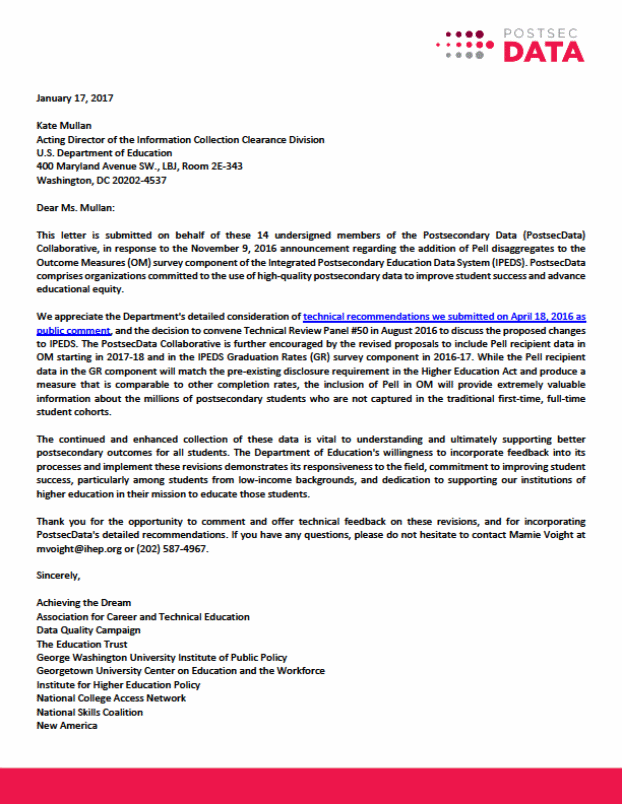

Dear Ms. Voight,
Thank you for commenting on behalf of the 14 postsecondary organizations posted on January 17, 2017 responding to a 60-day request for comments on proposed changes to the Department of Education’s Integrated Postsecondary Education Data System (IPEDS) 2017-20. The National Center for Education Statistics (NCES) appreciates your interest in IPEDS. The Paperwork Reduction Act (PRA) provides an opportunity for an open and public comment period where comments on collections can be made. We are grateful for this process and appreciative of Postsec Data’s support of all the proposed changes to the Outcome Measures survey component. We hope inclusion of more students will enhance and expand our understandings of the postsecondary completions of all students.
We thank you and the 14 organizations for collaborating to provide comment.
Sincerely Yours,
Richard J. Reeves
Postsecondary Branch Chief
Comments related to OM (Comment number 5)
Document: ED-2016-ICCD-0127-0009
Submitter’s Name: Kati Haycock
Date posted: January 17, 2017
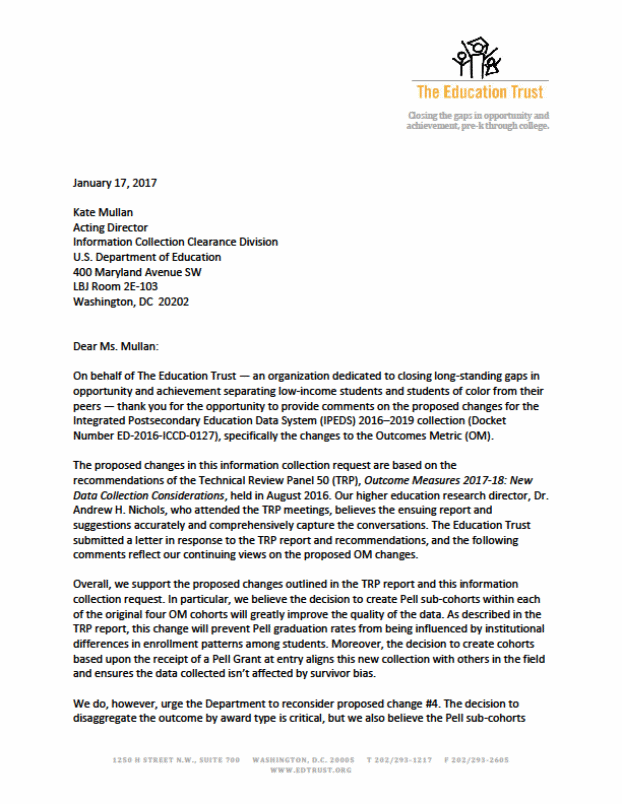
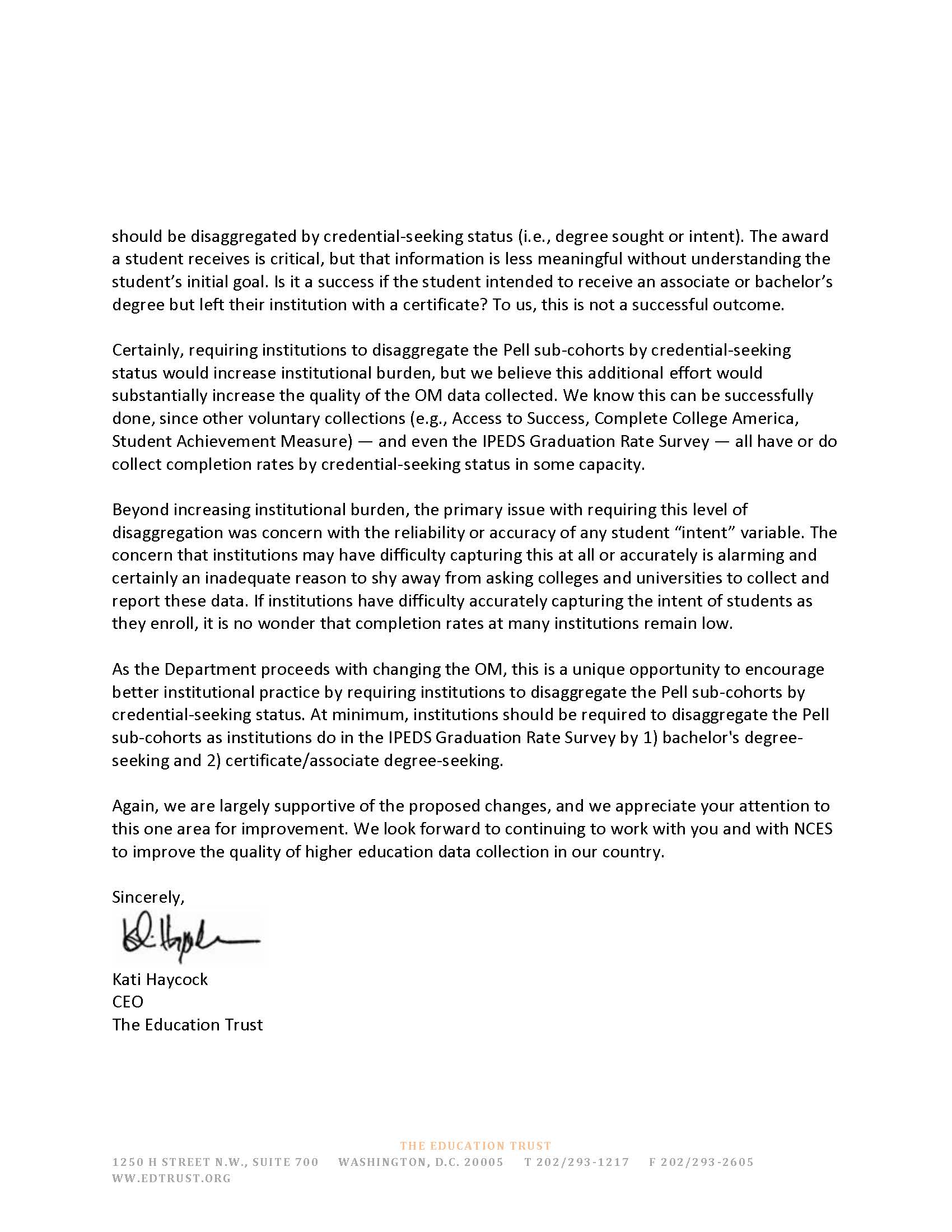
Response
Dear Ms. Haycock,
Thank you for your feedback posted on January 17, 2017 responding to a 60-day request for comments on proposed changes to the Department of Education’s Integrated Postsecondary Education Data System (IPEDS) 2017-20. The National Center for Education Statistics (NCES) appreciates your interest in IPEDS. The Paperwork Reduction Act (PRA) provides an opportunity for an open and public comment period where comments on collections can be made. We are grateful for this process and your overall supportive comment.
We thank you for sending your delegate to participate in the August 2016 Technical Review Panel (TRP), which discussed a variety of measures to collect better and useful information on all undergraduate students through the Outcome Measures (OM) survey component, which supplements the Graduation Rates (GR) survey component. As accurately summarized in your comment, the TRP discussed thoroughly the advantages and disadvantages of collecting data on students by degree sought. The TRP recommended that the most beneficial and least burdensome collection would be on degree awarded to student instead of degree sought. Furthermore, OM is not intended to replicate the collection from GR, but to supplement IPEDS existing student success measures. We hope that the suite of IPEDS student completion data will enhance discussions at the campus, state, and federal levels in supporting the postsecondary education progress of all students.
We thank you for taking the time to provide comment.
Sincerely Yours,
Richard J. Reeves
Postsecondary Branch Chief
Comments related to OM and General IPEDS Data Collection (Comment number 6)
Document: ED-2016-ICCD-0127-0009
Name: Lindsay Ahlman
Date posted: January 17, 2017
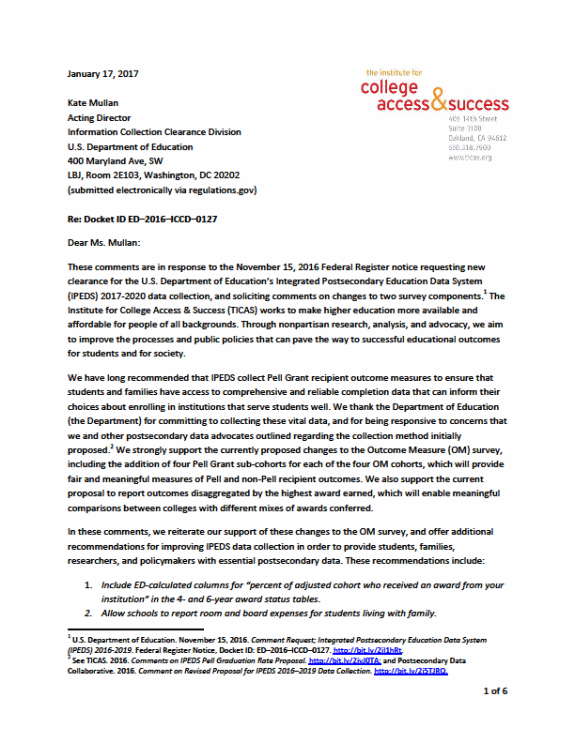
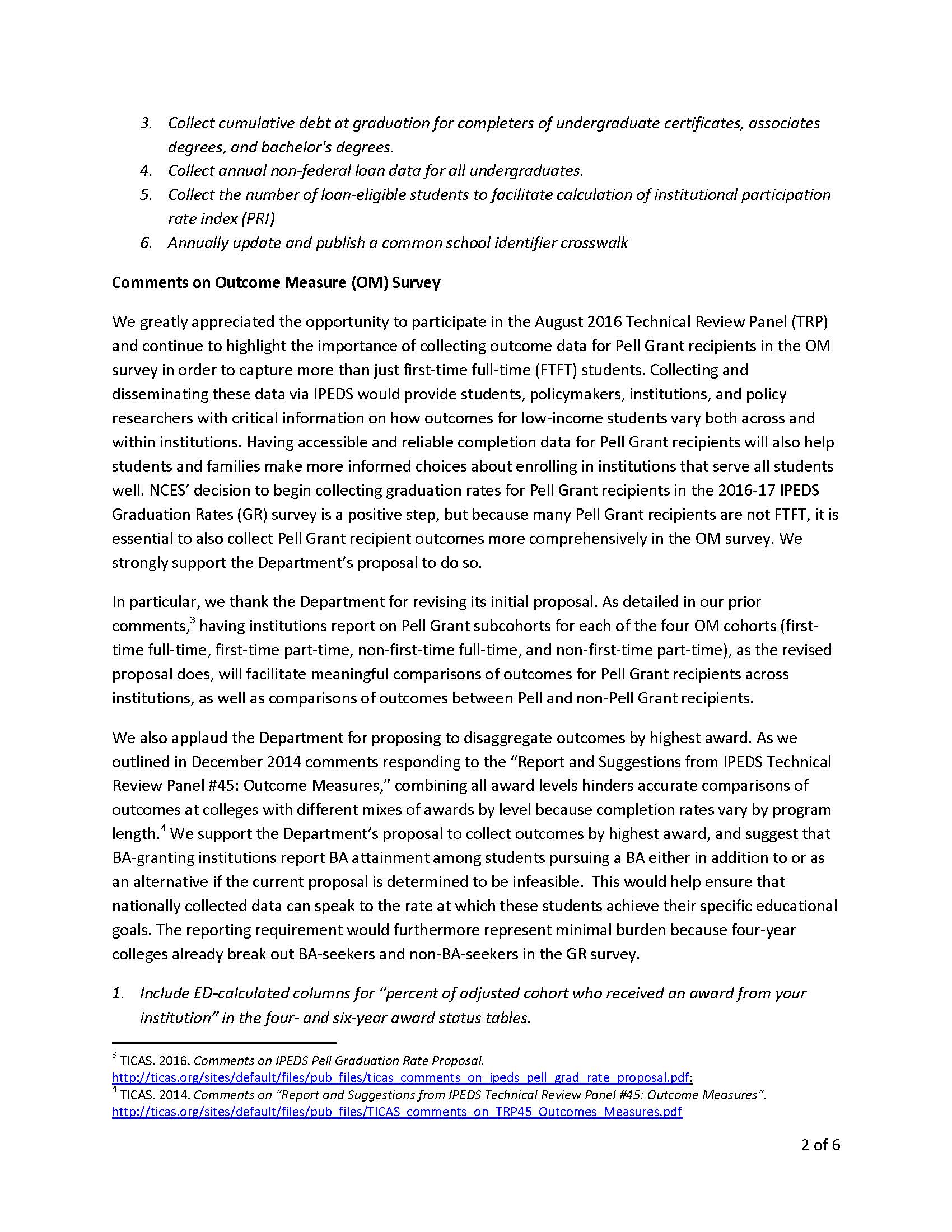
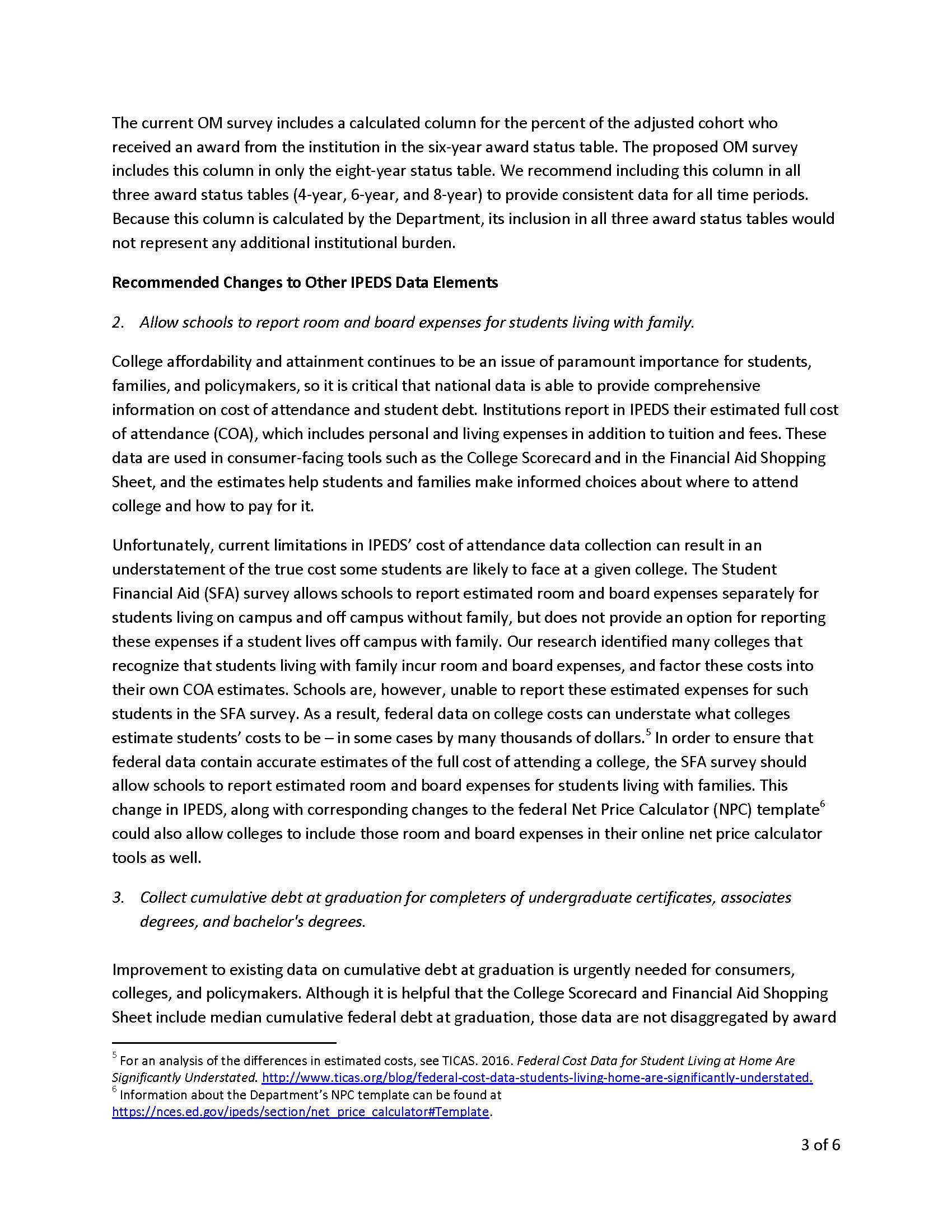
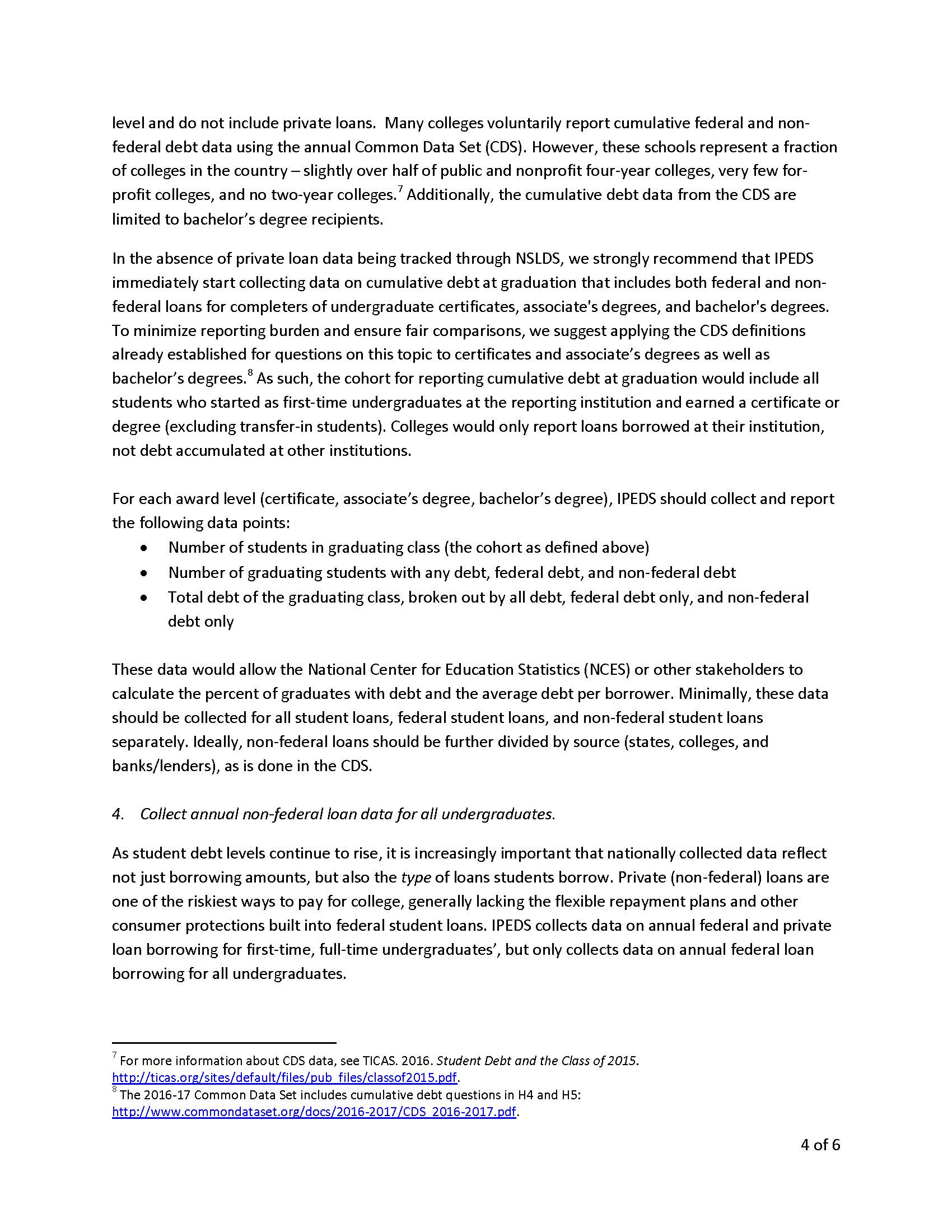
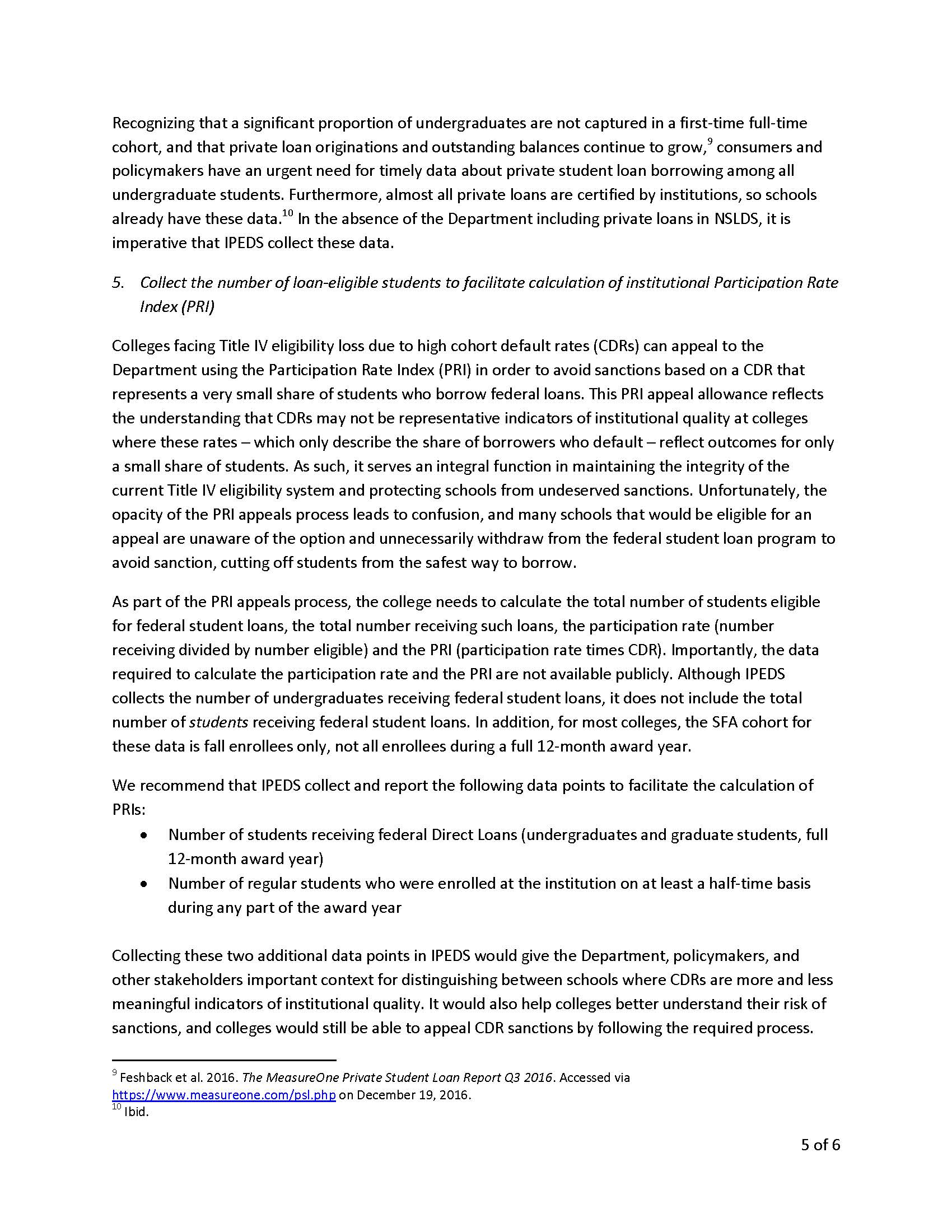

Response
Dear Ms. Ahlman,
Thank you for your feedback posted on January 17, 2017 responding to a 60-day request for comments on proposed changes to the Department of Education’s Integrated Postsecondary Education Data System (IPEDS) 2017-20. The National Center for Education Statistics (NCES) appreciates your interest in IPEDS. The Paperwork Reduction Act (PRA) provides an opportunity for an open and public comment period where comments on collections can be made. We are grateful for this process and your comment.
We are appreciative for your support of the proposed changes for the Outcome Measures (OM) survey component starting with the 2017-18 collection year. While we will not require institutions to report outcomes on BA-seeking and non-BA-seeking, as you correctly stated in your comment, we will require institutions to report on the highest degree, which will serve as a more meaningful measure for policy and data research as well as less burdensome for reporting institutions. The recommendation to calculate the percent adjusted cohort at all three time points (i.e., 4-, 6-, and 8-year) on the survey screens is a good one without imposing burden while enhancing the data collection.
For your second recommendation, ‘Allow schools to report room and board expenses for students living with family’, institutions would need to collect additional data for students living with families, as they do not have any way to estimate these types of costs, whereas they can more easily estimate these costs for students living on campus or renting apartments in the local economy. In addition, the variability of these costs would likely make any average number of limited utility for students. For these reasons, we do not see a value in including this new recommendation to the collection.
For the third recommendation, ‘Collect cumulative debt at graduation for completers of undergraduate certificates, associates degrees, and bachelor's degrees’, this type of collection is more appropriate for the Office of Federal Student Aid, where they have access to student unit record data on students loans. Asking institutions to collect and report this to IPEDS would be duplicative and burdensome for an administrative data collection.
For the fourth recommendation, ‘Collect annual non-federal loan data for all undergraduates’, at this time IPEDS does not have a directive to collect this information, nor has there been enough research into what would be collected in this category. Non-federal loans is a very large category encompassing such things as mortgage refinances, credit cards, more traditional loans, and etc. To truly make this useful information for the federal government, researchers, and students, more research needs to be done to clarify this category for IPEDS. In the meantime, we encourage utilizing the National Postsecondary Student Aid Study (NPSAS) data, another NCES collection which provides information non-federal loan data. Until then, NCES will need to investigate the feasibility of such a recommendation for IPEDS and may consider such a collection in the future, especially if the Department receives a directive.
For the fifth recommendation, ‘Collect the number of loan-eligible students to facilitate calculation of institutional participation rate index (PRI)’, at this time we do not have the directive to collect this level of information. This type of information is more appropriate for the Office of Federal Student Aid, and could be duplicative and burdensome for an administrative data collection.
Finally, for the sixth recommendation, ‘Annually update and publish a common school identifier crosswalk’, IPEDS has begun working on the creation of a common school identifier crosswalk, however, at this time there is not a crosswalk ready for public release by NCES. This project heavily relies on already limited resources and will not be released unless NCES can deliver to the public crosswalk that meets NCES high-quality of standards. As a workaround, IPEDS provides multiple identifiers in the IPEDS Use the Data Tools, which can be used by research organizations to create their own crosswalks.
We thank you for taking the time to provide comment.
Sincerely Yours,
Richard J. Reeves
Postsecondary Branch Chief
Comments related to OM (Comment number 7)
Document: ED-2016-ICCD-0127-0013
Name: Mark Pioli
Date posted: January 17, 2017
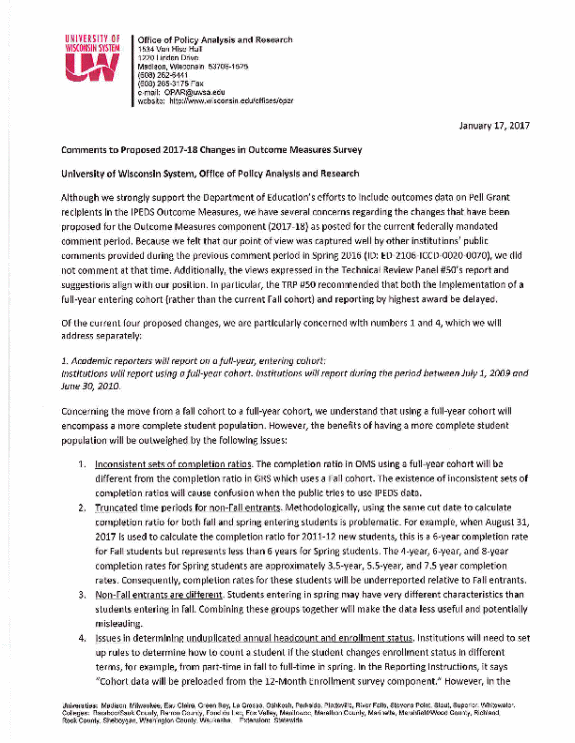
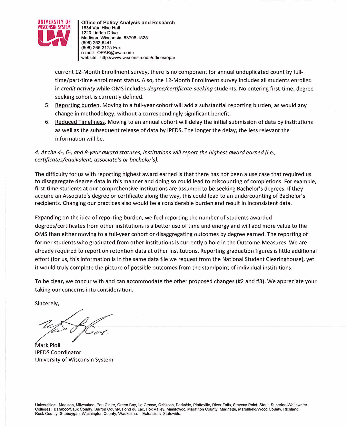
Response
Dear Mr. Pioli,
Thank you for your feedback posted on January 17, 2017 responding to a 60-day request for comments on proposed changes to the Department of Education’s Integrated Postsecondary Education Data System (IPEDS) 2017-20. The National Center for Education Statistics (NCES) appreciates your interest in IPEDS. The Paperwork Reduction Act (PRA) provides an opportunity for an open and public comment period where comments on collections can be made. We are grateful for this process and your comment.
Requiring institutions to report Outcome Measures data on a full-year cohort is imperative to the federal government. The proposed changes would allow for the inclusion of more students, in particular those students that enroll in the Spring that have not been included in prior cohorts. NCES strongly considered the increased institutional burden to which you provided specific examples by setting up specific coding rules, changing reporting methodology, and reporting at the highest degree awarded. Prior to proposing the changes, we spoke to other state-wide system coordinated institutions, who informed us reporting on a full-year cohort was feasible because they provide annual statistics in their reporting for state level reports. As such, NCES determined that the need to be accountable and transparent to the public outweighs the change in burden, particularly for Pell Grant recipients. In 2014-15 the federal government disbursed $30.3 billion in Pell Grants to 8.4 million full- and part-time undergraduate students (Federal Student Aid Data Center). The Pell Grant program is a large commitment of public dollars. It is imperative for the federal government to have comparable and comprehensive institutional data that reflects the outcomes of undergraduate and Pell-recipient populations.
While students who might start in the spring or summer of the entering cohort year may have a truncated time period to fall entrants, they will be captured in the eight year status point. Please remember that the 4-, 6- and 8-year in OM are time points that provide an update of a student’s progress toward completion. OM data should not be confused with Graduation Rates data that measures 100%, 150%, and 200% of normal time from the time of entry. Therefore, NCES does not believe there would be reduced timeliness in the data reported to OM as the data are about three status points over an eight year period from point of entry.
We understand that for many institutions, non-fall entrant students may differ in many ways from students admitted in the fall. However, a primary purpose of the Outcome Measures (OM) survey is to address the limitations of the Graduation Rates survey component, which collects data on first-time, full-time (FTFT) undergraduate students, across degree-granting postsecondary institutions. Academic reporting institutions are currently required to report a Fall census based cohort, excluding students that were admitted outside of the Fall census. The limitations of defining a cohort as FTFT and fall census have been a great critique by the current and past Administrations, Congress, and data users. The OM survey component allows for a more complete collection and inclusive depiction of the overall student progression on an increasingly diverse undergraduate student population.
Furthermore, the purpose of the Outcome Measures (OM) survey component is to address the limitations of the Graduation Rates survey component. The collection of graduation rates is defined by statute (Student Right to Know and Campus Security Act) and restricted to data collection on first-time, full-time undergraduate students. The OM survey is not defined similarly and thus provides the opportunity to follow the original recommendations of the 2012 Committee on Measures of Student Success, which were to broaden the coverage of student graduation data to reflect a more diverse student population at two-year institutions and improve the collection of the overall student progression and completion data. With this purpose in mind, OM is not intended to replicate the collection from GR, but to supplement IPEDS existing student success measures. We hope that the suite of IPEDS student completion data will enhance discussions at the campus, state, and federal levels in supporting the postsecondary education progress of all students. We also hope that institutions and state coordinators will work with the Department of Education and NCES to help explain the more inclusive suite of student success measures.
Finally, we agree that institutions should also be focused on reporting their transfer out data, but the overall aim of NCES is to support your timely and accurate reporting. We cannot avoid the need to report on all students that attend your institutions as well as those who transfer out. To that end, we will continue to encourage discussions and knowledge-share at our upcoming April 2017 State Coordinator meeting where reporting requirements (i.e., reporting on transfer outs and how to set up reporting on highest degree award) could be made possible. We also hope that the State Coordinator listserv serves as a helpful forum for productive and informative discussions.
We thank you for taking the time to provide comment.
Sincerely Yours,
Richard J. Reeves
Postsecondary Branch Chief
Comments related to OM (Comment number 8)
Document: ED-2016-ICCD-0127-0010
Name: Margaret Cohen
Date posted: January 17, 2017
I have concerns about the proposal to change the cohort definition for academic year-based institutions. Currently, the cohort is defined as students entering as of a given date in the fall semester. The students could have been new in fall or the preceding summer. Changing the definition to include all students entering the institution from July 1 through June 30th does not fit the calendars of these institutions.
If it was absolutely necessary to have the cohort represent a complete year what would fit the calendar better would be to just add those who enter in spring semester or the winter and spring quarters to the existing cohort. This would maintain some consistency to what institutions have been doing and would make reprogramming to report on the newly defined cohort much less burdensome.
Some issues with the July 1 to June 30th cohort definition are:
1.Students who start June 1 and students who start July 1 all start the same summer but would be assigned to different cohorts. This does not seem logical.
2.The time period to be included as "completed" would be less for those starting June 1 than for those starting July 1. For example, the 6-year period ending August 31 for baccalaureate degree seekers starting June 1 would be 5 years and 3 months while for those starting July 1 it would have 6 years and 2 months.
3.This will create burden for institutions by increasing the number of programs they will need for cohort reporting. The programs necessary for OM won't even be able to build on existing ones.
If this change is implemented, there will be inconsistencies in the definitions of entering cohorts within IPEDS (between GR and OM) and between OM and the disclosures mandated by HEOA. Many consumers will not understand the difference with the potential of making the institution's data suspect.
Finally, how will NCES inform consumers of the data about using two different cohorts?
Response
Dear Ms. Cohen,
Thank you for your feedback posted on January 17, 2017 responding to a 60-day request for comments on proposed changes to the Department of Education’s Integrated Postsecondary Education Data System (IPEDS) 2017-20. The National Center for Education Statistics (NCES) appreciates your interest in IPEDS. The Paperwork Reduction Act (PRA) provides an opportunity for an open and public comment period where comments on collections can be made. We are grateful for this process and your comment.
Requiring institutions to report their Outcome Measures data on a full-year cohort is imperative to the federal government. The proposed changes would allow for the inclusion of more students in particular those students that enroll in the Spring that have not been included in prior cohorts. NCES strongly considered the increased institutional burden and determined that the need to be accountable and transparent to the public outweighs the change in burden, particularly for Pell Grant recipients. In 2014-15 the federal government disbursed $30.3 billion in Pell Grants to 8.4 million full- and part-time undergraduate students (Federal Student Aid Data Center). The Pell Grant program is a large commitment of public dollars. It is imperative for the federal government to have comparable and comprehensive institutional data that reflects the outcomes of undergraduate and Pell-recipient populations.
To that end, we appreciate the specific concerns that you brought forth in your comment. Because we have established a July 1-June 30 timeframe for program reporters, it is logical to require academic reporters to follow the same timeframe. In addition, the timeframe aligns with the federal financial aid award year of July 1-June 30. This also aligns with the IPEDS Completion and 12-Month Enrollment surveys.
While students who might start in the spring or summer of the entering cohort year may not have a full six years, they will be captured in the eight year status point. Please remember that the 4-, 6- and 8-year in OM are time points that provide an update of a student’s progress toward completion. OM data should not be confused with Graduation Rates data that measures 100%, 150%, and 200% of normal time from the time of entry. NCES strongly considered the increased institutional burden when proposing the changes to the Outcome Measures (OM) survey component.
NCES takes institutional burden seriously and we have contracted with a reputable, independent research office to investigate the time used to completing IPEDS surveys. While we understand there is a marked increase in institutional burden with new changes to OM, we determined that the need to be accountable and transparent now to the public outweighs the change in burden, particularly for Pell Grant recipients.
As a reminder, the purpose of the Outcome Measures (OM) survey component is to address the limitations of the Graduation Rates survey component. The collection of graduation rates is defined by statute (Student Right to Know and Campus Security Act) and restricted to data collection on first-time, full-time undergraduate students. The OM survey is not defined similarly and thus provides the opportunity to follow the original recommendations of the 2012 Committee on Measures of Student Success, which were to broaden the coverage of student graduation data to reflect a more diverse student population at two-year institutions and improve the collection of the overall student progression and completion data. With this purpose in mind, OM is not intended to replicate the collection from GR, but to supplement IPEDS existing student success measures. We hope that the suite of IPEDS student completion data will enhance discussions at the campus, state, and federal levels in supporting the postsecondary education progress of all students. We also hope that institutions and state coordinators will work with the Department of Education and NCES to help explain the more inclusive suite of student success measures.
We thank you for taking the time to provide comment.
Sincerely Yours,
Richard J. Reeves
Postsecondary Branch Chief
Comments related to OM (Comment number 9)
Document: ED-2016-ICCD-0127-0011
Name: Anonymous Anonymous
Date posted: January 17, 2017
Dear Ms. Mullan:
Thank you for the opportunity to comment. There is considerable concern with reporting burden related to the following two proposed OM survey revisions:
Similar to program reporters, all reporting institutions to the OM survey will be given the same instructions when creating their OM cohort:
Institutions will report using a full-year cohort. Institutions will report on students that enrolled during the period between July 1, 2009 and June 30, 2010.
Four Pell Grant sub-cohorts will be reported for each of the four OM cohorts (FTFT, PTFT, FTNFT, and PTNFT).
There will be extreme burden on state IPEDS coordinating agencies that collect higher education institution microdata via annual, standardized submissions and then generate and upload IPEDS OM survey data on their behalf. Pell recipient and full-year enrollment status markers may not have been part of state agency data collection efforts in 2009-10 and, thus, not in a state data system until recently or at all.
Please note data elements captured at the state level are often aligned with state and federal reporting needs. Additional data elements not in state or federal statute are excluded as part of collection efforts to lessen burden at the institution-level. Mandating Pell Grant sub-cohorts and full-year reporting as part of the OM survey now means retroactively establishing cohorts from eight years ago because it was not captured as of part data collection efforts at that time. To do this, supplementary data collection efforts will likely be needed by state agencies. The supplementary submission microdata then have to be woven in to the state longitudinal data system. Once again, this will be extremely burdensome.
Optional reporting or delayed implementation for the Pell Grant sub-cohorts and full-year reporting as part of the OM survey is strongly encouraged to allow for state standardized annual collection and validation to occur for Pell and Enrolment Status markers moving forward.
Realistically, IPEDS should have notified state agencies and higher education institutions nine years ago if they wanted Pell Grant sub-cohorts and full-year reporting.
Thank you.
Response
Dear Anonymous,
Thank you for your feedback posted on January 17, 2017 responding to a 60-day request for comments on proposed changes to the Department of Education’s Integrated Postsecondary Education Data System (IPEDS) 2017-20. The National Center for Education Statistics (NCES) appreciates your interest in IPEDS. The Paperwork Reduction Act (PRA) provides an opportunity for an open and public comment period where comments on collections can be made. We are grateful for this process and your comment.
NCES strongly considered the increased institutional burden when proposing the changes to the Outcome Measures (OM) survey component. NCES takes institutional burden seriously and we have contracted with a reputable, independent research office to investigate the time used to completing IPEDS surveys. The researchers are currently in the field and will report the results later this year.
While we understand there is a marked increase in institutional burden with new changes to OM, we determined that the need to be accountable and transparent now to the public outweighs the change in burden, particularly for Pell Grant recipients. Delaying or making OM 2017-18 an optional year of reporting was considered prior to posting of the 2017-18 OM changes. However, the federal government disbursed $30.3 billion in Pell Grants to 8.4 million full- and part-time undergraduate students in 2014-15 (Federal Student Aid Data Center), making it vital that we begin to collect these data sooner rather than later. The Pell Grant program is a large commitment of public dollars. It is imperative for the federal government to have comparable and comprehensive institutional data that reflects the outcomes of undergraduate and Pell-recipient populations.
We thank you for taking the time to provide comment.
Sincerely Yours,
Richard J. Reeves
Postsecondary Branch Chief
| File Type | application/vnd.openxmlformats-officedocument.wordprocessingml.document |
| Author | Authorised User |
| File Modified | 0000-00-00 |
| File Created | 2021-01-23 |
© 2026 OMB.report | Privacy Policy